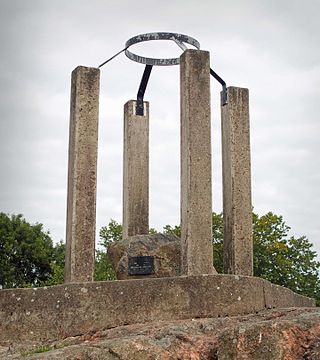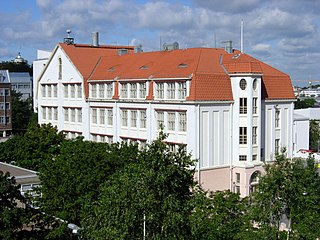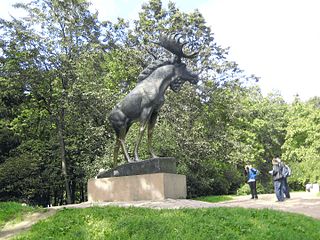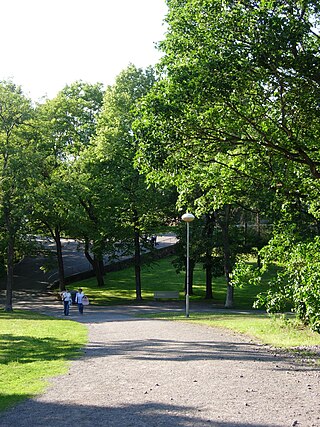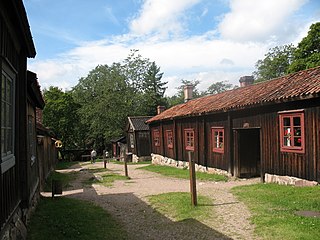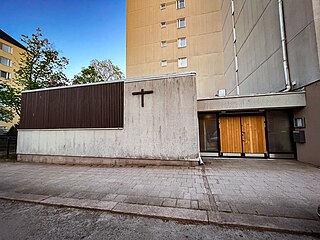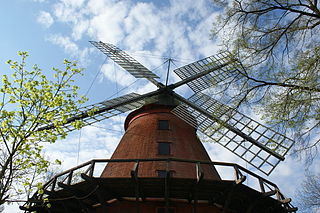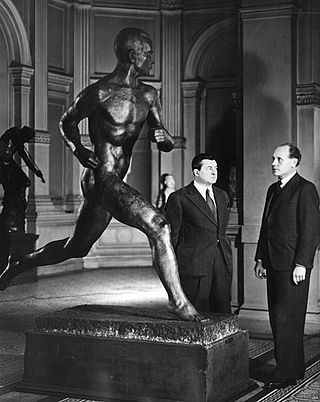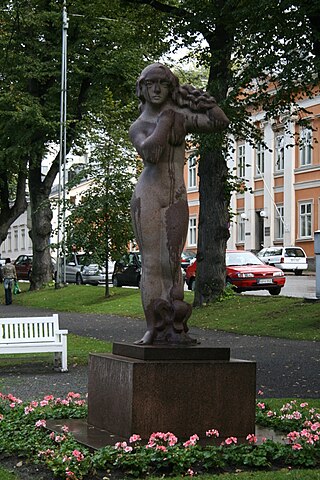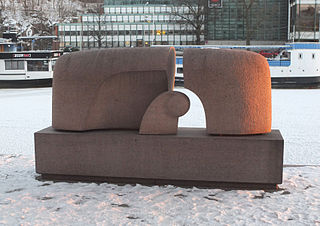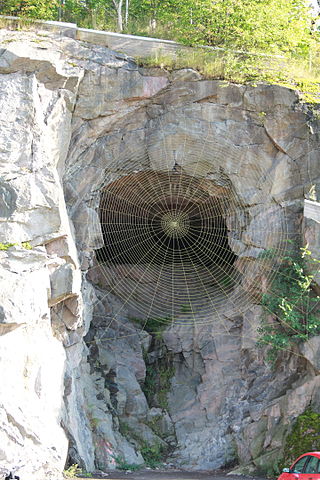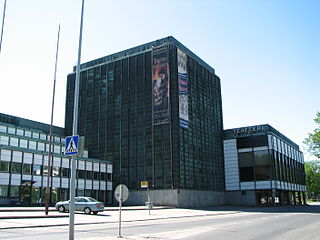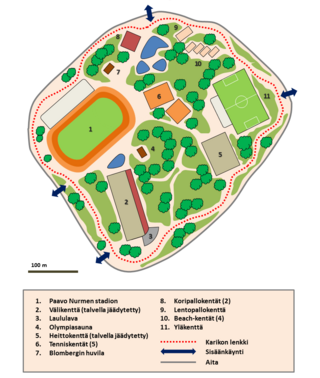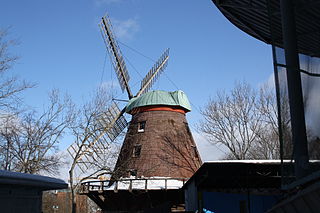Self-guided Sightseeing Tour #3 in Turku, Finland
Legend
Tour Facts
7.8 km
0 m
Experience Turku in Finland in a whole new way with our self-guided sightseeing tour. This site not only offers you practical information and insider tips, but also a rich variety of activities and sights you shouldn't miss. Whether you love art and culture, want to explore historical sites or simply want to experience the vibrant atmosphere of a lively city - you'll find everything you need for your personal adventure here.
Activities in TurkuIndividual Sights in TurkuSight 1: Turun punavankileirin muistomerkki 535
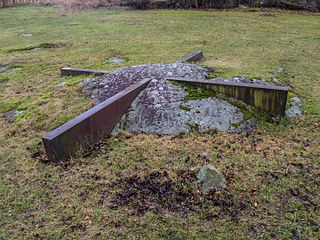
The memorial "535" of the Turku Red Prison Camp was designed by artist Ismo Kajander and executed by Reijo Möttönen, a metal teacher at the Turku Adult Education Centre, on the slope of Kurjenkaivonkenttä field in Turku. The artwork was unveiled in 1994 on the site where the Turku prison camp had been located after the Civil War. At its peak, there were 3300 Red prisoners in the camp, 175 of whom perished.
Wikipedia: Turun punavankileirin muistomerkki ”535” (FI), Website
Sight 2: Hirsipuumäen teloituspaikan muistomerkki
The memorial to the execution site of Hirsipuumäki was designed by Esko Hillilä in 1991. This is a project of the City of Turku by the museum's archaeologist Heljä Brusila and then city architect Jorma Aho. The memorial is located in Turku on Kerttulinmäki, next to Kerttul Upper Secondary School, on one of Turku's seven hills. Previously, the hill was known as Hirttomäki or Gallows Hill. A plaque on the monument bears inscription stating that the place was the place of execution of the city from the Middle Ages to the end of the 1700s.
Sight 3: Hirsipuumäki
Kerttulinmäki is a hill located in the first district of Turku. It is one of the seven hills of Turku.
Sight 4: Hirvi
Moose is a sculpture by sculptor Jussi Mäntynen from 1923. Its bronze castings were erected in Vyborg in 1928, Lahti in 1955, Turku in 1969 and Helsinki in 1972.
Sight 5: Temppeli
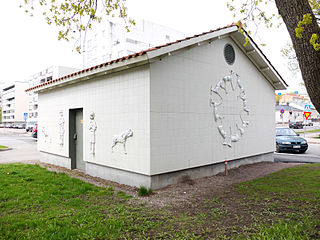
The temple is a sculpture by Kim Simonsson in Turku's Kupittaanpuisto park. It is a multi-part relief on the outer walls of a small transformer substation building. The transformer substation is located on the corner of Uudenmaankatu and Kupittaankatu. The work was unveiled in Turku's Capital of Culture year 2011.
Sight 6: Summan taistelun muistomerkki
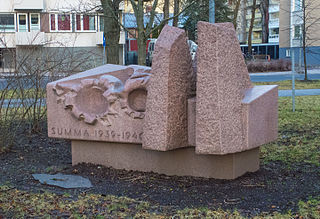
The memorial to the Battle of Summa is a sculpture by Jussi Vikainen in Turku between Kupittaankatu and Itäinen Pitkäkatu in Kupittaankenttä. The work is made of red granite, i.e. stone for which Vikainen's birthplace Vehmaa is famous. The monument was unveiled in 1965 and erected by the Tradition Committee of Southwest Finland Summa to commemorate the battles of the Winter War (1939–40).
Sight 7: Vartiovuori Observatory
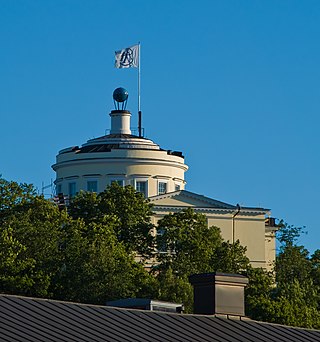
Vartiovuori Observatory is a former observatory in Turku, Finland. The observatory, designed by Carl Ludvig Engel, was originally built for the Royal Academy of Turku. The neoclassical building was completed in 1819. The observatory is situated atop the Vartiovuori hill, and it is clearly visible from different sides of the city centre.
Sight 8: Vartiovuori
Vartiovuorenmäki is a hill and park area located in the II district of Turku city centre. The height of the hill is 50 meters above sea level. The park is known for, among other things, the observatory building designed by Carl Ludvig Engel in the 1810s and the traditional Turku Summer Theatre.
Sight 9: Luostarinmäki
Luostarinmäki Handicrafts Museum is an open-air museum in Turku, Finland.
Sight 10: Suolla
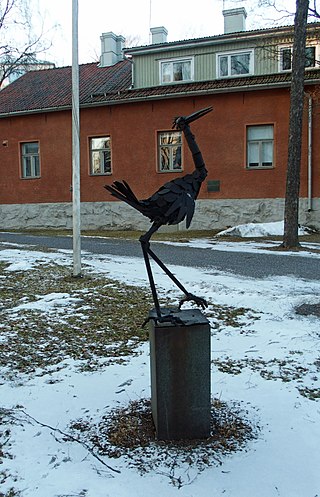
There is a sculpture by Veikko Haukkavaara in the yard of a daycare centre at Luostarinkatu 5 in Turku. The main material of the work is steel and iron elements, which Haukkavaara has welded together. The subject of the sculpture is a bird in a swamp that just seems to be taking a step forward. The unveiling took place in 1973.
Sight 11: Turun baptistiseurakunta
Turku Baptist Church is a Baptist church founded in Turku in 1887. Its activities were initially in Swedish, but later the congregation became Finnish-speaking. The parish prayer room is located at Vähä-Hämeenkatu 16. In 1996 there were about 150 members and about 200 people in operation. The current number of members is also about 150.
Sight 12: Turun sotaveteraanien muistomerkki
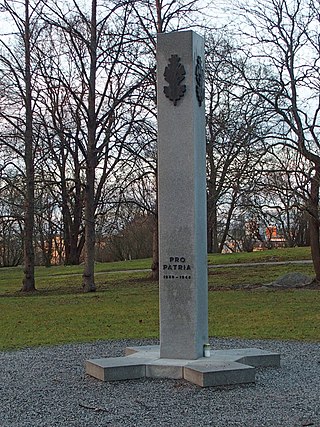
The Turku War Veterans Memorial is a sculpture designed by Aarne Ehojoki in Samppalinnanpuisto, Turku. The unveiling ceremony was in 1992.
Sight 13: Samppalinnanpuisto
Samppalinnanpuisto, also known as Samppalinnanvuori, is one of the parks in Turku. In the park are located e.g. Samppalinna restaurant, outdoor swimming pool and Luostarivuori school. Its plant range includes more than 60 different woody plant species. The name of the place derives from the ancient castle that was located on the site. In Southwest Finland, the word sampa or thrush has meant a boundary marker or pile.
Sight 14: Itsenäisyyden kivi
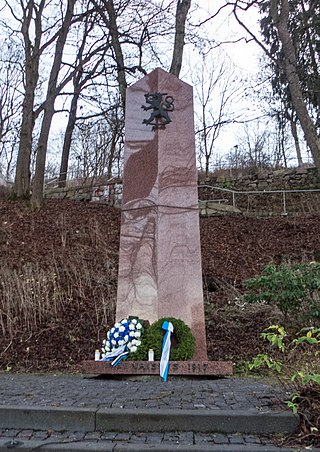
The Stone of Independence (1977) is a sculpture by sculptor Antti Louhisto, located on the slope of Samppalinna on Itäinen Rantakatu in Turku. The work is a quadrangular obelisk tapering upwards, the material of which Louhisto has used granite. At the top of the obelisk is the emblem of the State of Finland, the lion. The work was unveiled in connection with the 60th anniversary of Finland's independence on 6 December 1977.
Sight 15: G. A. Petrelius, Äiti ja lapsi
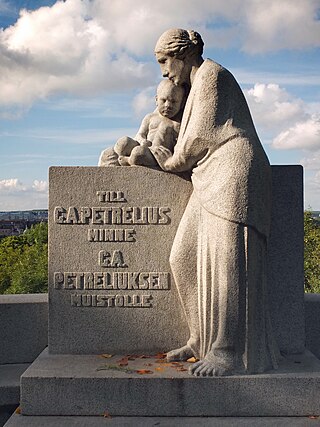
The monument to G. A. Petrelius Mother and Child is a sculpture located in Samppalinnanpuisto Park in Turku. It was completed in 1914 and erected in memory of municipal councillor Gustav Albert Petrelius in 1915. The sculpture was designed by Felix Nylund.
Sight 16: Dominikaaniluostarin muistomerkki
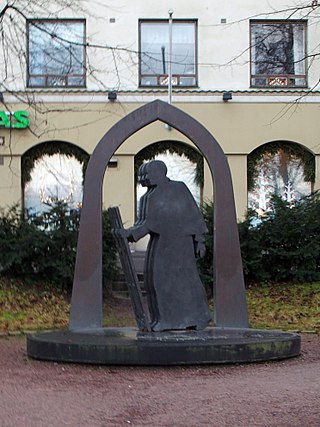
Dominicans in Turku is a sculpture in front of the head office of Veritas pension insurance company in Kaskenmäki, Turku. The sculpture, made by Kimmo Ojaniemi, was unveiled in 2005, the centenary year of the Veritas company.
Sight 17: Paavo Nurmi
The Paavo nurmi statue is a whole-body sculpture of runner Paavo Nurmi, the most successful Olympic athlete in Finland, made by sculptor Wäinö Aaltonen. The bronze sculpture was made in 1925 and there have been four additional casts of it. The statue has become a symbol for Finnish sport and the independent Finnish nation as well as an envoy of the image of Finland.
Sight 18: Heikki Nurmio
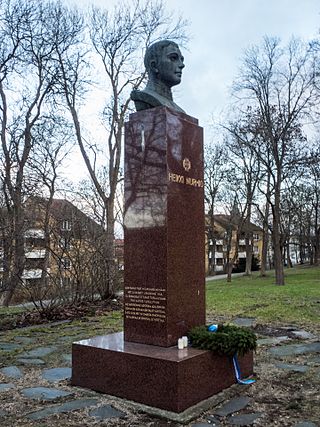
The Heikki Nurmio statue is a sculpture in Turku's Vartiovuori Park, made by Kalervo Kallio in 1962.
Sight 19: Lilja
Lilja is a red granite sculpture by Wäinö Aaltonen, located in Turku, Finland. It is located in Runeberginpuisto near the Aurasilta. It depicts the lily, the flower of the Turku coat of arms. In 1927, the statue was the first public art commission in Turku.
Sight 20: Qwenselin talo
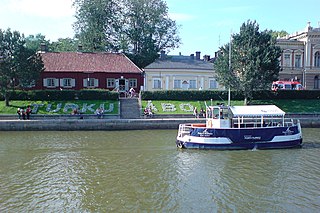
The Qwensel House is the oldest wooden house in Turku, Finland. It is bourgeois housing from the autarchic times that has survived in its entirety. The house was built approximately in the year 1700 in an area that was reserved for the nobility in the city plan made up by Per Brahe the Younger in 1652. Today, the Qwensel House operates as the Turku Pharmacy Museum and café.
Sight 21: Kauppa, Teollisuus ja Säästäväisyys
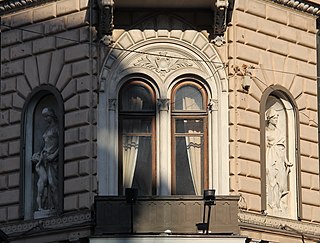
Commerce, Industry and Frugality are three sculptures made by Emil Wikström for Turku Savings Bank, which were placed on the façade of the bank building in 1891.
Sight 22: Suojattu kasvu
Protected Growth is a granite sculpture located on the west bank of the Aura River in Turku, created by sculptor Jarkko Roth from Vehmaa. The work, completed in 1983, was donated to the city by Rakennusliike Kivikartio in connection with its 40th anniversary celebration in 1985. Pauli Lappalainen, the founder of Kivikartio, said that the work depicts the sheltered growth environment that the steadily developing Turku offers to a company striving forward.
Sight 23: Turun Linnantontun ja Valpuri Innamaan kohtaaminen Teatterisillalla
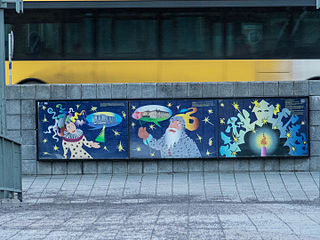
The meeting between Turku Castle Elf and Valpuri Innamaa at Theatre Bridge is a three-part environmental artwork created by Turku-based sculptor Jan-Erik Andersson at Turku Theatre Bridge. The work was completed in 1998, the bridge the previous year. The work is part of the Pro Cultura Foundation's environmental art project.
Wikipedia: Turun Linnantontun ja Valpuri Innamaan kohtaaminen Teatterisillalla (FI), Website
Sight 24: Network
Get Ticket*Network is an environmental artwork designed and manufactured by architect Outi Sarjakoski in Turku, Turku, at the intersection of Itäinen Rantakatu and Volter Kilven katu. The size of the "cobweb" is about 12×15 meters. Sarjakoski braided the net himself from polyester rope, which took about one kilometre for the work.
Sight 25: Aleksis Kivi
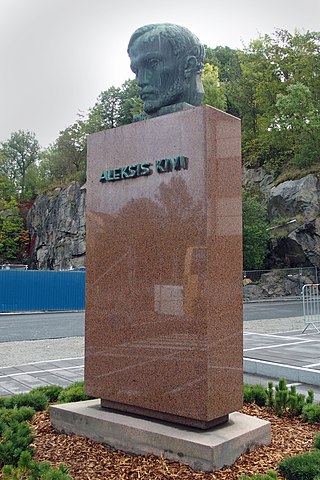
The Aleksis Kivi memorial in Turku is a bronze statue designed by sculptor Wäinö Aaltonen along Itäinen Rantakatu.
Sight 26: Turku City Theatre
Turku City Theatre is a theatre in the City of Turku. It was founded in 1946, when "Turun Teatteri" and "Turun Työväen Teatteri" merged. It was the oldest fully municipality owned theatre in Finland, until 2014, when it became a joint-stock company owned by the City of Turku.
Sight 27: Urheilupuisto
Turku Sports Park is a sports and recreation area located in the centre of Turku, on the eastern bank of the Aura River. The extensive park area includes several sports facilities, some of which are open all year round. The most significant areas of the park are the Paavo Nurmi Stadium and the upper field, which serves as both a football and American football field. The park also has a disc golf course, outdoor exercise equipment, and several tennis, basketball and volleyball courts. In winter, the park's fields are frozen for ice games. The park is surrounded by the Karikon lenkki fitness track, named after Paavo Karikos, who was Finland's first municipal sports instructor from 1938 to 1969.
Sight 28: Samppalinnan tuulimylly
Samppalinna Windmill is a windmill in Turku, completed in 1860, which today is one of the city's attractions. Samppalinna Summer Theatre operates in the vicinity of the mill.
Sight 29: Myrsky
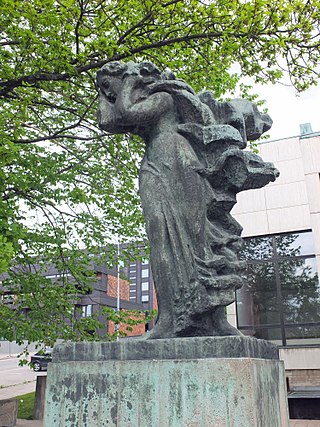
The Storm is a sculpture by Wäinö Aaltonen, which will be placed on the outdoor terrace of his museum in Turku, at Itäinen Rantakatu 38.
Sight 30: Carro Celeste
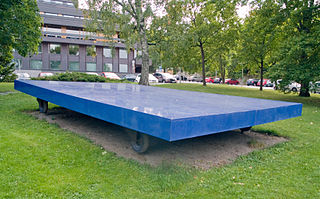
Carro Celeste is an environmental artwork by Italian-born Mariella Bettineschi in Turku. It was unveiled in 1994 on Independence Square between the City Theatre and the Wäinö Aaltonen Museum, but has been moved to make way for the construction site of the new Turku Music Centre.
Sight 31: Gaian silmä
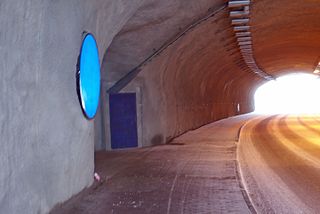
Gaia's Eye (1998) is a light installation by Kimmo Ojaniemi embedded in the wall of Turku's Myllytunnel using glass, acrylic, stainless steel and fluorescent tubes. The work is based on James Lovelock's Gaia hypothesis, conceived in the 1960s, according to which the Earth is a self-directed entity capable of keeping our planet suitable for habitation. In Greek mythology, Gaia is a goddess whose mission is to protect life and the Earth.
Sight 32: Jäinen meri
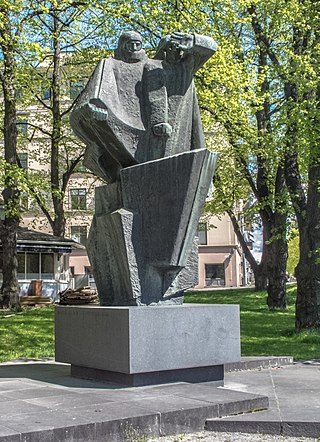
The Icy Sea is a bronze sculpture by Raimo Utriainen in Turku's Borenpuisto park between Linnankatu and Aurajoki, on the corner of Koulukatu and near Myllysilta. The sculpture, unveiled in 1961, was erected by the City of Turku as a memorial to winter navigation in Turku. The name August Uppman is engraved on the pedestal of the sculpture. He was a sea captain who founded the Steamship Company Bore. Boren Park, where the sculpture is located, and the nearby Bore House across School Street are also named after the company.
Sight 33: Kimono
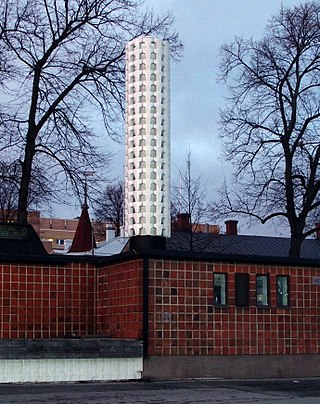
Kimono is Karin Widnäs' ceramic artwork by the Aura River in Turku. The tower of the wastewater pumping station is clad with ceramic tiles, the shape of which gives the work the name Kimono. It changes its color slowly according to the rhythm of the day, from blue through purple to dawn pink. Kimono was unveiled on the opening day of Turku's Capital of Culture year on 15.1.2011.
Share
Disclaimer Please be aware of your surroundings and do not enter private property. We are not liable for any damages that occur during the tours.
GPX-Download For navigation apps and GPS devices you can download the tour as a GPX file.
